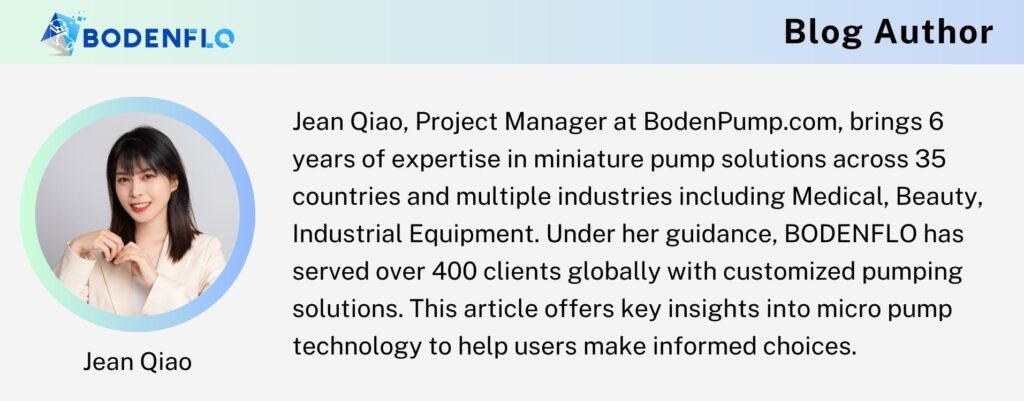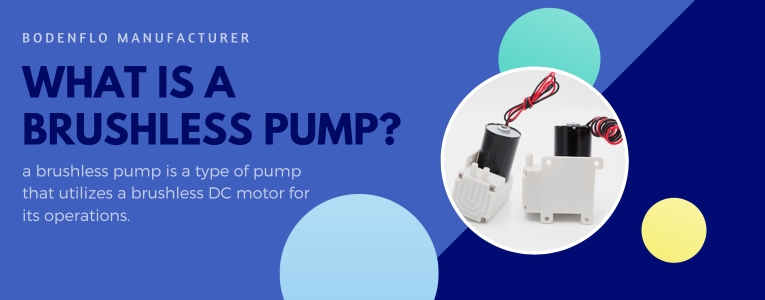
If you're in the industry of micro-pumps or miniature pumping solutions, you've likely come across the term "brushless pump" and wondered what sets it apart. From procurement officers seeking highly efficient components to company owners like Janne Matikainen who focus on quality and performance, understanding the intricacies of brushless pumps can be a game-changer.
Simply put, a brushless pump is a type of pump that utilizes a brushless DC motor for its operations. The absence of brushes results in reduced friction, leading to higher efficiency, longer lifespan, and less maintenance.
Curious to know more? Excellent, because we're about to dive into the technical and practical aspects of brushless pumps.
What Sets Brushless Pumps Apart?
When looking for a pump solution, the decision between brushless and brushed pumps often comes up. Both have their merits, but what makes brushless pumps stand out? Here, we'll delve into the unique attributes that differentiate brushless pumps from traditional brushed pumps.
Motor Configuration
At the core of a brushless pump lies its Brushless DC (BLDC) motor, which is a fundamental component whether you're dealing with a brushless air pump 12V or a more powerful 24V DC brushless air pump. Unlike traditional brushed motors, which use carbon brushes for commutation, BLDC motors employ permanent magnets and sophisticated electronic controllers for the same purpose. This architecture eliminates the need for brushes, reducing friction and subsequently lowering heat generation. The net result is a notable improvement in operational efficiency, a quality that remains consistent across various voltage options like 12V and 24V DC for brushless air pumps.
Robustness and Reliability
Thanks to their motor configuration, bldc pumps offer an added layer of reliability. The absence of brushes results in fewer mechanical parts that can wear out, thereby enhancing the durability of the pump. This makes brushless pumps a preferred choice for applications requiring continuous and long-term operations.
Adaptability
Another point worth noting is the adaptability of brushless pumps. The electronic controllers allow for more precise control of speed and torque, offering greater flexibility in tuning the pump's performance according to specific application requirements.
Low Electromagnetic Interference (EMI)
An often-overlooked advantage of brushless pumps is their ability to produce low levels of electromagnetic interference (EMI). Brushed motors generate sparks during commutation, contributing to higher levels of EMI. In contrast, brushless motors, by virtue of their electronic commutation, significantly reduce this interference. This is especially critical in applications where low EMI is required, such as medical equipment, precision instrumentation, and settings where sensitive electronic devices are in use.
Advanced Functionalities for Precision and Control
DC brushless air pumps are engineered to offer sophisticated control features, among which Pulse Width Modulation (PWM) and Frequency Generator (FG) outputs are the most prevalent and beneficial. PWM facilitates intricate control over motor speed and torque, thereby optimizing energy efficiency. The FG signal is specifically designed to serve as a feedback loop, delivering real-time data on the motor's rotational speed for precise monitoring. While these are the most commonly used features, brushless pumps can be equipped with additional functionalities to meet specialized requirements. This advanced level of control and feedback options sets brushless pumps apart in terms of precision and adaptability.
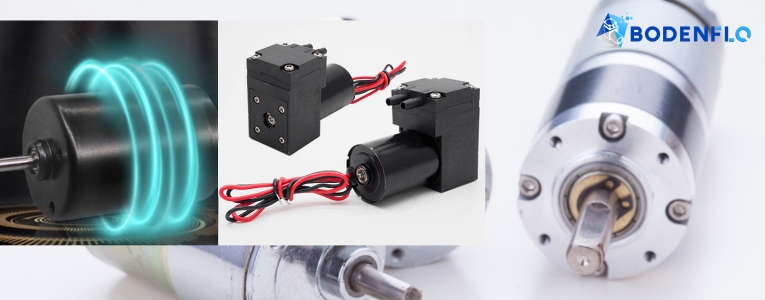
Why are the brushless pump so Efficient?
In the world of micro pumps, efficiency isn't just a buzzword—it's a critical parameter that directly affects operational costs and performance. The efficiency of a pump can be a determining factor in the success of applications ranging from medical devices to industrial machinery. But what makes brushless pumps especially efficient? Let's break it down.
Energy Utilization
The electronic commutation in brushless pumps minimizes electrical losses, which is a common problem in brushed motors. By reducing these losses, the pump operates at a higher overall efficiency, converting more of the electrical power into actual work. This is particularly beneficial in battery-powered applications where maximizing energy use is vital.
Dynamic Performance
Brushless pumps, specifically brushless DC air pumps or BLDC air pumps, are distinguished by their dynamic performance range, enabled by electronic control systems. This control allows the pumps to operate effectively across a diverse array of speeds and loads. Such adaptability ensures that whether you're using a brushless DC air pump or a BLDC air pump, the device is always functioning at an optimal point on its performance curve. The ability to fine-tune operations based on specific needs contributes significantly to the overall efficiency and versatility of brushless pumps.
Reduced Heat Generation
Minimal friction due to the absence of brushes also leads to lower heat generation. Excessive heat can degrade the efficiency of a pump by affecting the viscosity of the fluids and causing wear on internal components. Brushless pumps mitigate this by operating at cooler temperatures, prolonging not just efficiency but also the life of the pump.
How Long Do They Last?
When it comes to purchasing pumps for industrial or commercial use, lifespan is often a critical factor that procurement officers and business owners carefully consider. After all, a pump's longevity not only influences maintenance costs but also impacts overall system reliability. So, how do brushless pumps score on this front? Let's delve into the specifics.
Reduced Mechanical Wear
In a brushless pump, the absence of brushes eliminates one of the primary sources of mechanical wear. In brushed pumps, these brushes degrade over time, requiring frequent replacements and leading to intermittent downtime for maintenance. Without these components, brushless pumps experience significantly less wear and tear, enhancing their operational longevity.
Material Advancements
Brushless pumps often incorporate advanced materials like high-grade polymers or specialized metals that are engineered for durability. These materials resist the corrosive effects of the fluids they handle and also withstand the mechanical stress induced during operation. The combination of material science and design innovation contributes to the extended life of the pump.
Maintenance Savings
Longevity in brushless pumps translates to reduced maintenance intervals and less frequent replacement of parts. This contributes to lower operational costs over the life of the pump. While initial investment may be higher, the reduced maintenance and longer operational life often yield a lower total cost of ownership.
Reliability Through the Years
Studies indicate that the mean time between failures (MTBF) for brushless pumps is considerably higher compared to brushed pumps. The high MTBF signifies a more reliable operation, which in turn, assures a longer functional lifespan. This reliability is especially beneficial in mission-critical applications where system failure can have dire consequences.
What are the BLDC Pumps Applications?
Comprehending the wide application spectrum of brushless pumps, including brushless dc air pump and brushless mini air pumps, is crucial for selecting the ideal pump tailored to your unique requirements. Owing to their inherent efficiency, reliability, and low-maintenance characteristics, brushless pumps have found a specialized role in various industry sectors. Whether you're considering a standard brushless air pump for high-flow applications or a brushless mini air pump for compact and portable needs, understanding where and why these pumps excel can help you make an informed choice. This proficiency in specific applications is often why brushless pumps are the preferred option in diverse industries.
Medical Sector
In the medical industry, the demand for highly reliable and precise pumping solutions is paramount. Brushless pumps are often deployed in critical care devices such as ventilators, infusion pumps, and dialysis machines. Their high efficiency and low heat generation are especially beneficial in these sensitive applications.
Industrial Automation
Industrial automation relies heavily on the consistency and reliability of its components. Brushless pumps are used in cooling systems, hydraulic actuators, and fluid transfer systems. Their high efficiency and adaptability to variable speeds make them ideal for automated processes that require precise control.
Specialized Machinery
Whether it's aerospace engineering or high-precision manufacturing, specialized machinery often requires pumps that can operate under extreme conditions. Brushless pumps meet these requirements through their robust design and material advancements, making them suitable for applications that involve high pressure, high temperature, or corrosive environments.
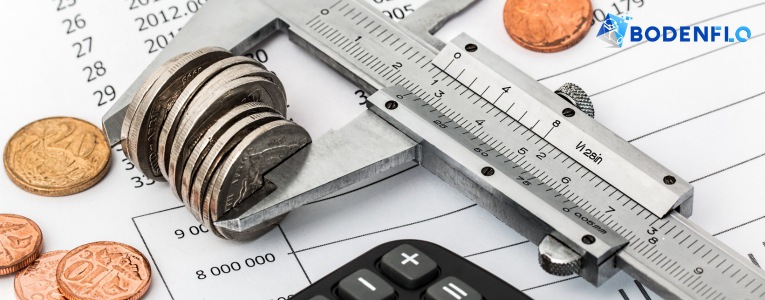
Are They Cost-effective?
Cost-effectiveness is a critical factor in any procurement decision. While the initial cost of brushless pumps, miniature brushless air pump might be higher than their brushed counterparts, it's essential to look beyond the upfront expenses. So, how do brushless pumps measure up in terms of long-term cost-effectiveness? Let's examine the elements that contribute to this aspect.
Total Cost of Ownership (TCO)
When evaluating the cost-effectiveness of brushless pumps, it's prudent to consider the Total Cost of Ownership (TCO). This includes not just the initial purchase price but also operational and maintenance costs over the life of the pump. DC brushless pumps typically offer a lower TCO due to reduced maintenance intervals and longer lifespan.
Energy Savings
Brushless pumps are more energy-efficient, which translates to savings on electricity bills. This is particularly important in large-scale or continuous operations where even a slight improvement in efficiency can result in significant cost reductions over time.
Reduced Downtime
Frequent maintenance or unexpected failures can result in costly downtime for businesses. Brushless pumps, with their high reliability and longer Mean Time Between Failures (MTBF), can significantly reduce these unplanned operational halts, thereby enhancing productivity and reducing associated costs.
How Do They Compare to Traditional Pumps?
The debate between traditional brushed pumps and brushless pumps is not just a matter of technological preference but also involves practical considerations that can impact performance and costs. To truly appreciate the advantages of brushless pumps, it's crucial to examine how they compare with their traditional brushed counterparts in key areas.
Efficiency Quotient
Brushless pumps typically outshine brushed pumps in terms of hydraulic, volumetric, and mechanical efficiency. This is mainly due to the absence of brush friction and lower electrical losses, allowing for superior energy conversion and, ultimately, more effective pumping.
Longevity and Maintenance
As previously discussed, the lack of brushes minimizes wear and tear, significantly prolonging the life of the pump. On the other hand, brushed pumps tend to require more frequent maintenance, including brush replacements, which adds to operational costs.
Complexity and Control
One area where traditional pumps may have an edge is simplicity. Brushless pumps require electronic controllers or specialized drivers to manage their operation, making them slightly more complex to integrate into existing systems. However, this complexity often provides greater control and adaptability, benefits that are increasingly valuable in modern applications.
By dissecting these comparison points, decision-makers can better evaluate the suitability of brushless pumps vis-à-vis traditional pumps for their specific application needs.
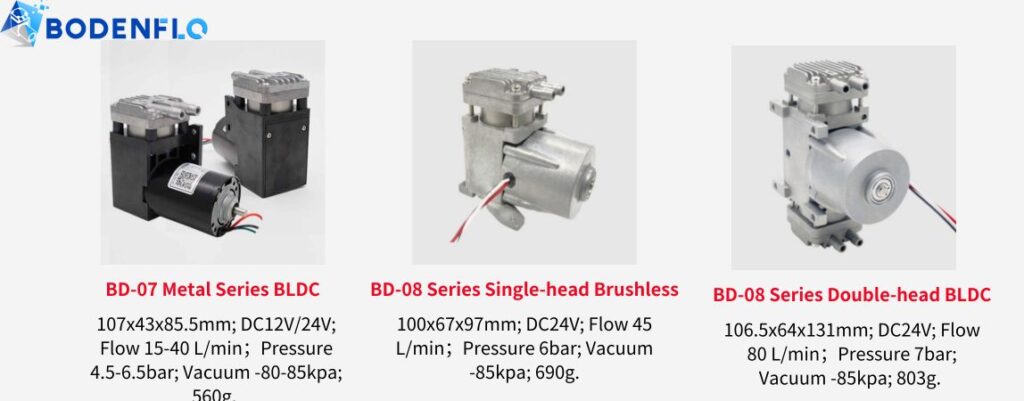
Conclusion
To sum up, brushless pumps or bldc air pump offer a range of benefits that make them a compelling choice for a variety of applications. They are efficient, long-lasting, and, in the long run, cost-effective. Whether you're a procurement officer or a company owner, considering brushless pumps could be a smart business decision for your operational needs.
By understanding the nuances of these pumps, we can make better procurement choices that align with both performance and budgetary considerations. Thank you for joining us on this exploration of brushless pumps.
That's it. If you're looking for customizable and high-efficiency dc micro brushless pumps, look no further than BODENFLO brushless air pump manufacturer. Feel free to contact us for any further inquiries.

